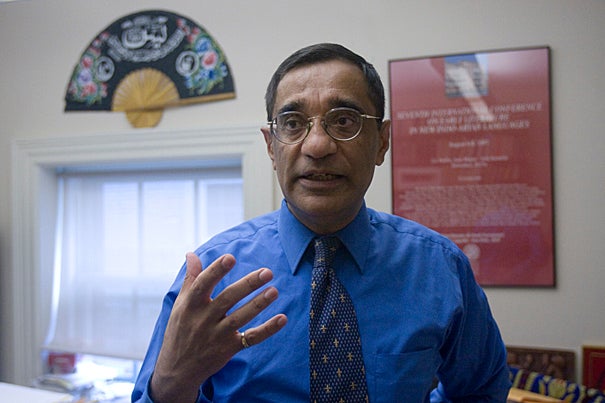
Asani’s use of the arts as a teaching tool is just part of his broader effort to eradicate what he calls “religious illiteracy.” For more than 30 years, he has dedicated himself to helping others better understand the rich subtext and diverse influences that make religion — in particular, Islam — a complex cultural touchstone.
Kris Snibbe/Harvard Staff Photographer
Interpreter of cultures
Ali Asani uses arts to explain, appreciate Islam
Using art forms, such as poetry, music, and calligraphy, Ali Asani is combating ignorance about Islam and Muslim cultures.
In his office, dotted with delicate weavings and tapestries, and stacked with books on religion and languages, Asani proudly shows off the product of a recent academic endeavor, a handful of music videos created by his students. In the short clips, the men and women are singing their own compositions, inspired by a verse from the Koran.
“The arts help to humanize cultures where political discourses based on nationalist ideologies tend to dehumanize. They are wonderful pedagogic bridges that help to connect peoples who perceive those different from themselves as ‘the other,’ ” said Asani, Harvard professor of Indo-Muslim and Islamic religion and cultures.
Asani’s use of the arts as a teaching tool is just part of his broader effort to eradicate what he calls “religious illiteracy.” For more than 30 years, he has dedicated himself to helping others better understand the rich subtext and diverse influences that make religion — in particular, Islam — a complex cultural touchstone.
“For me, religion is a cultural phenomenon that is complexly embedded in historical, political, economic, literary, and artistic contexts. As these contexts change, people’s interpretation of religion changes, so it’s never really something that is fixed.”
Those who refuse to see understandings of religion as contextually constructed engage in a dangerous form of religious illiteracy, said the scholar, one that “strips people in a very broad way of their humanity. Looking at people through the exclusive lens of their religious identity and ignoring their historical, cultural, and political contexts is dehumanizing and leads to stereotyping and sometimes to even genocide and ethnic cleansing.”
His quest is partly personal. Asani, who came to the United States as a young man directly from his native Nairobi to attend college, was stunned when his American peers challenged his African heritage.
“Because of the way I looked, people were questioning that I really could be African,” recalled the scholar, who has ancestral ties to South Asia. “I thought it was very strange, since my family has roots in Africa dating back 200 years.”
“It was my first encounter with what people in the United States know about the rest of the world. Most of my peers had no idea of Africa’s racial, cultural, and religious diversity. I hoped it was something that I would get a chance to remedy someday. And then I found out there were larger problems in the academy about how Islam is taught and understood.”
Asani came to Harvard as an undergraduate in 1973 and has been here ever since. A concentrator in comparative religion, he later pursued his doctorate work on Near Eastern languages, developing his dissertation on the ginans, the religious texts of the Ismaili branch of Islam. Capitalizing on his multilingual fluency in Urdu, Hindi, Persian, Gujarati, Sindhi, and Swahili, he began teaching at Harvard’s Department of Near Eastern Languages and Civilizations. Today a tenured professor, his research focuses on Shia and Sufi devotional traditions of Islam, as well as popular or folk forms of Muslim devotional life.
In keeping with his mission of promoting religious literacy, Asani held workshops for educators following the terrorist attacks of Sept. 11, 2001, to help them better understand Islam. He also recently developed a detailed historic and cultural curriculum for the study of Muslim societies for the Islamic Studies Initiative, an international professional development program for high school teachers in Kenya, Pakistan, and Texas.
Most recently, Asani, who is also associate director of Harvard’s Prince Alwaleed Bin Talal Islamic Studies Program, has been working on incorporating the arts into his “Culture and Belief” course, which is offered as part of Harvard’s new Program in General Education.
“I am interested in exploring the use of the arts not only as lenses to study religious traditions but also as a means of engaging students in deeper forms of learning through art making,” he said.
“By studying and appreciating a piece of art or a piece of literature from a different culture and then attempting to re-create that artistic or literary form within their own cultural framework, students participate in learning processes that are intimate and bear the imprint of their own personalities. In this manner, education can truly become personally transformative.”




